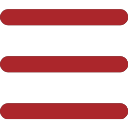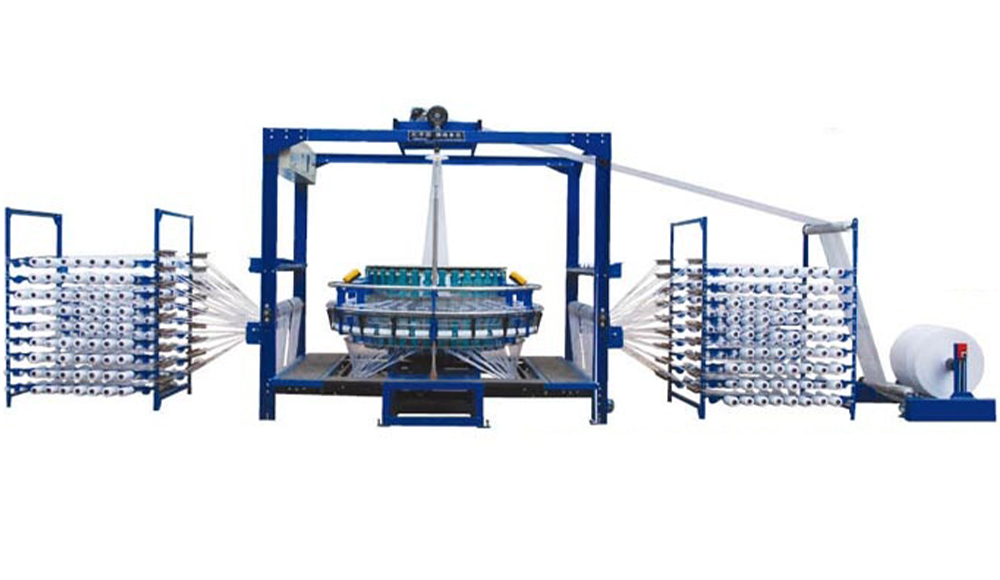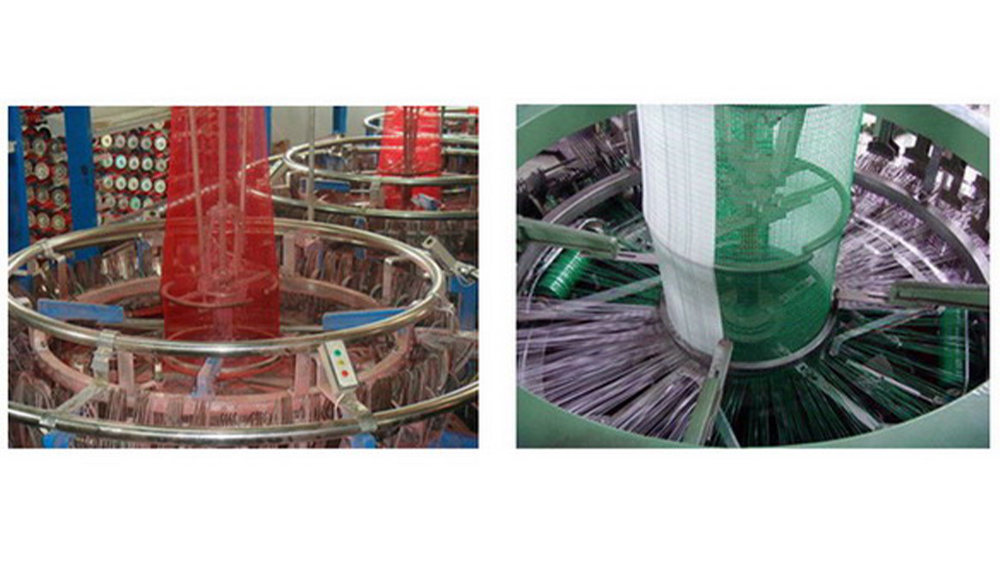

Circular looms play a crucial role in the production of PP woven sacks. These specialized machines are designed to weave polypropylene tapes into fabric tubes, which are then used to create sturdy and durable sacks. The circular loom operates by continuously weaving the tapes in a circular motion, resulting in seamless tubular fabric. This fabric is later cut and stitched to form PP woven sacks of various sizes and specifications.
Circular looms are available in different configurations, allowing manufacturers to produce sacks with varying features such as different colors, sizes, thickness, and printing designs. The weaving process on circular looms ensures that the fabric remains strong and tear-resistant, making it ideal for packaging applications where durability is essential.
Circular looms are indispensable machines in the packaging industry, especially for producing PP woven sacks. These sacks are widely used for packaging products such as grains, seeds, fertilizers, cement, chemicals, and more. The versatility of circular looms enables manufacturers to customize the sacks according to specific customer requirements.
Comparison Table: Circular Looms vs. other Weaving Machines
| Aspect | Circular Looms | Conventional Weaving Machines |
|---|---|---|
| Operation Efficiency | High | Moderate |
| Tubular Fabric Quality | Seamless and Durable | Seams may compromise strength |
| Customization Options | Varying Colors and Designs | Limited options |
| Application Range | Wide range of Industries | Limited mostly textile industry |
In conclusion, circular looms play a vital role in the production of PP woven sacks for the packaging industry. Their efficiency, quality output, and customization capabilities make them an essential asset for manufacturers looking to meet diverse packaging needs without compromising on durability and strength.
In the production of PP woven sacks, manufacturers have the option to choose between flat and tubular circular looms. **The main difference between the two lies in the type of fabric tube they produce**. Flat circular looms create a flat fabric sheet which is then folded and stitched to form the sack. On the other hand, tubular circular looms weave tapes into seamless tubular fabric directly, eliminating the need for additional stitching processes.
Circular looms can also be categorized based on the weaving technology used, namely shuttle and shuttleless looms. **Shuttle circular looms** employ a shuttle device to carry the weft yarn across the warp threads during weaving, while **shuttleless circular looms** utilize alternative methods such as rapier or projectile systems for weft insertion. Shuttleless looms are known for their higher weaving speeds and efficiency compared to shuttle looms.
By understanding the different types of circular looms and their functionalities, manufacturers can choose the most suitable machine based on their production requirements and preferences. Each type offers distinct advantages in terms of efficiency, weaving quality, and versatility that cater to various needs in PP woven sack manufacturing.

In the production of PP woven sacks, manufacturers require specific materials to operate the circular looms effectively. These materials typically include polypropylene (PP) resin granules, which serve as the primary raw material for weaving the fabric. Additionally, manufacturers need various additives such as UV stabilizers and color masterbatches to enhance the properties and appearance of the woven sacks. It is essential to have high-quality tapes or flat yarns that are durable and suitable for weaving into strong, reliable sacks.
The weaving process using circular looms involves several sequential steps to manufacture PP woven sacks efficiently. Firstly, the PP resin granules are melted and extruded to create tapes or flat yarns that serve as the weft threads in the weaving process. These tapes are then fed into the circular loom where they are interlaced with the warp threads to form a sturdy fabric tube. The loom operates based on its type, whether flat or tubular, shuttle or shuttleless, to weave the fabric according to the desired specifications.
Once the fabric tube is woven, it undergoes additional processes such as lamination, printing, cutting, and stitching to transform it into a functional sack ready for packaging various goods. Manufacturers may incorporate specific designs or branding during the printing phase to customize the sacks according to their clients' requirements. Finally, the finished PP woven sacks undergo quality checks to ensure they meet standards regarding strength, dimensional accuracy, and aesthetic appeal before being dispatched for distribution.
By following these systematic steps and utilizing appropriate materials and machinery, manufacturers can effectively weave high-quality PP woven sacks using circular looms tailored to their production needs.
Manufacturers leveraging circular looms for PP woven sack production benefit from their cost efficiency and enhanced productivity. The automated weaving process carried out by circular looms reduces manual labor requirements, leading to increased production output within a shorter timeframe. This results in cost savings associated with reduced manpower and streamlined manufacturing processes. Additionally, circular looms have the capability to operate continuously without significant downtime, ensuring optimal utilization of resources and maximizing overall output efficiency.
The utilization of circular looms in PP woven sack production presents various environmental advantages and contributes to sustainability efforts. Circular looms generate minimal waste during the weaving process due to their precise material utilization and efficient fabric formation mechanisms. By producing woven sacks with minimal material wastage, manufacturers can contribute to reducing environmental impact and promoting sustainable manufacturing practices. Furthermore, the use of recyclable polypropylene materials in the production process aligns with eco-friendly initiatives aimed at minimizing plastic waste and fostering a more sustainable industrial sector.
Manufacturers may encounter challenges in operating circular looms for PP woven sack production due to the intricate nature of these machines. The complex weaving mechanisms and automation processes require specialized training for operators to ensure smooth functionality and optimal output. Ensuring that the looms are properly calibrated and maintained is essential to avoid disruptions in the production workflow and maintain consistent product quality. Addressing these complexities proactively through training programs and regular equipment checks can help mitigate operational challenges associated with circular loom weaving.
Circular looms used in PP woven sack production may also face maintenance and repair issues that can impact manufacturing efficiency. Regular upkeep tasks such as lubrication, parts replacement, and cleaning are crucial to prevent breakdowns and downtime. In cases where repairs are needed, sourcing replacement parts and technical support for complex components of circular looms can pose challenges that delay production schedules. Implementing a structured maintenance schedule and having contingency plans for addressing repair issues promptly can minimize operational disruptions and ensure continuity in weaving operations.
Manufacturers are observing a shift towards automation and digitalization trends in circular looms utilized for PP woven sack production. These advancements aim to streamline operations and improve overall efficiency by reducing manual intervention and enhancing process control. Automation technologies such as robotic arms for material handling and digital controls for weaving parameters are becoming integral to modern circular loom designs. By embracing these trends, manufacturers can optimize production processes, minimize human errors, and increase output consistency.
The incorporation of Internet of Things (IoT) and Artificial Intelligence (AI) in circular loom manufacturing is revolutionizing the industry by enabling predictive maintenance and real-time monitoring capabilities. IoT sensors can collect data on machine performance and operating conditions, allowing for proactive maintenance scheduling based on usage patterns. AI algorithms analyze this data to identify potential issues before they escalate, enabling efficient troubleshooting and minimizing unplanned downtime. By leveraging IoT and AI technologies, manufacturers can enhance operational efficiency, prolong equipment lifespan, and ensure continuous production of high-quality PP woven sacks.

Manufacturers of circular looms for PP woven sack production are witnessing a significant transformation driven by market trends and demands. The increasing focus on sustainability, cost-effectiveness, and product quality has propelled the demand for advanced circular looms that can efficiently produce high-quality woven sacks. As industries across sectors such as agriculture, construction, and packaging adopt PP woven sacks for their durability and versatility, the market for these sacks is experiencing steady growth. Circular loom manufacturers are adapting to these trends by incorporating innovative technologies to meet the evolving needs of customers and stay competitive in the global market.
Circular loom manufacturers play a crucial role in meeting the evolving needs of industries reliant on PP woven sacks. By embracing automation, digitalization, IoT, and AI technologies in their manufacturing processes, these manufacturers can enhance the efficiency, reliability, and performance of their circular looms. With a focus on producing woven sacks that are not only durable but also environmentally friendly, manufacturers are investing in research and development to create sustainable solutions that align with market demands. By staying abreast of industry trends and leveraging cutting-edge technologies, circular loom manufacturers can continue to drive innovation in the production of PP woven sacks globally.
Circular looms have become integral to the production of high-quality PP woven sacks due to their ability to meet market demands for sustainability and product quality. By incorporating advanced technologies and focusing on environmental considerations, circular loom manufacturers are driving growth in the global market for woven sacks.
Industry professionals should closely monitor market trends and technological advancements in circular loom manufacturing to ensure competitiveness. Embracing innovation and sustainable practices can help companies meet evolving industry needs while contributing to a more environmentally conscious production process.
2024-03-19
2024-03-13
2024-03-05
2024-02-28